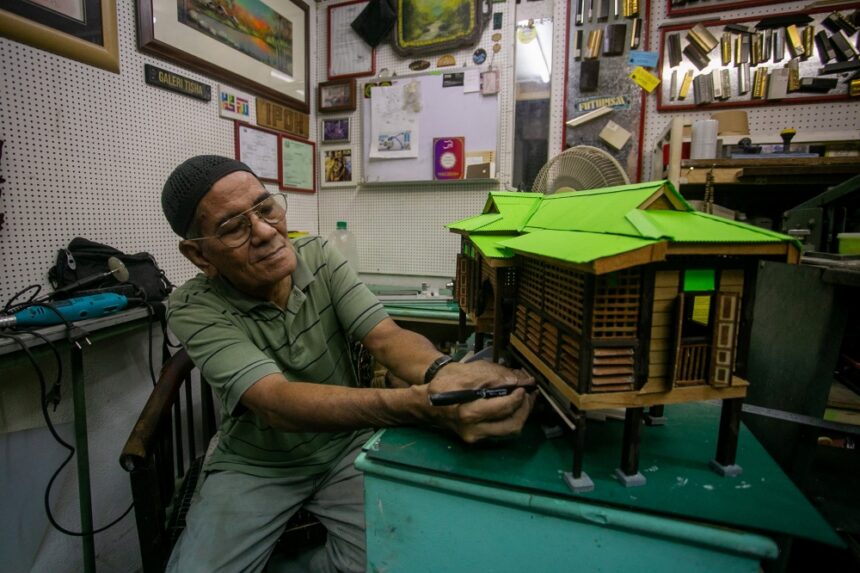IPOH, March 25 — Decades ago, veteran carpenter Saari Ali often accompanied his late father, Ali Mat Rashid, as he built houses.
Through these experiences, Saari, 70, honed his skills in woodcraft, particularly in constructing traditional Malay houses.
Today, after four decades in the trade, the master craftsman from Gopeng remains dedicated to house construction but has shifted his focus to crafting miniature house replicas.
With the carpentry expertise and experience passed down from his father, Saari has a rare ability to recreate traditional house replicas with remarkable accuracy, entirely from memory, without the need for sketches or blueprints.
The father of four shared that in crafting these replicas, he relies on photographs he takes during village visits and images provided by customers as references.
Saari Ali showcases traditional house replicas he created at his gallery in the Urban Transformation Centre (UTC) building in Ipoh recently. — Bernama pic
“I never imagined that my woodworking skills of turning pieces of wood into miniature house replicas would one day become a source of income for my family.
“I learned carpentry from my father, and from there, my passion for creating traditional Malay house replicas grew,” he told Bernama when met at Galeri Tisha, located at the Urban Transformation Centre (UTC) Perak.
Saari shared that many of his traditional house replicas were inspired by cherished memories of working alongside his father, as well as his deep appreciation for traditional architecture.
“Typically, if someone works as a house carpenter, it’s easier for them to transition into making traditional house replicas since they already have the basic skills.
“I never had formal training under anyone and mostly relied on my experience working with my late father,” said Saari, who also has a talent for oil painting on canvas.

With the carpentry expertise and experience passed down from his father, Saari Ali has a rare ability to recreate traditional house replicas with remarkable accuracy, entirely from memory, without the need for sketches or blueprints. — Bernama pic
Saari pointed out that each replica he crafts carries its own distinct identity, reflecting the architectural styles of various villages he has visited, particularly in Perak.
“If you visit Kampung Gajah, Parit, or Kuala Kangsar, you’ll notice that each traditional house has its own unique design, with slight variations. My goal is to create replicas of every type of traditional house found in Perak.
“I often receive orders for traditional house models such as the Melaka, Johor and even the Negeri Sembilan Minangkabau-style houses, which is particularly popular,” he said, adding that it takes anywhere from three weeks to a month to complete one, depending on the size.
“Each replica crafted must be carefully detailed with windows, pillars, staircases, intricate carvings, and decorative motifs to ensure it closely resembles the original house,” he explained.
“I can’t simply design however I please because each replica is based on an actual house. My goal is to produce more traditional house replicas for future generations to appreciate.

Saari Ali said his miniature houses typically measure 0.3 m in height and 0.6 m in length, with prices ranging from RM1,000 to RM5,000, depending on the size and architectural style. — Bernama pic
“Many youngsters today have never had the experience of living in a traditional house. If you visit villages now, you’ll see that many of these homes are no longer occupied,” he lamented.
Saari said his miniature houses typically measure 0.3 m in height and 0.6 m in length, with prices ranging from RM1,000 to RM5,000, depending on the size and architectural style.
“The smaller the replica, the more expensive it is, as the crafting is more intricate. Generally, only those with a deep appreciation for this art form are willing to invest in these pieces,” he said.
Saari hopes someone will continue his legacy, however, he has observed little interest among the younger generation.
“So far, no young people have come to my gallery at Pasar Besar Ipoh, which has been open since 1983, to learn this skill. If this continues, my craft may fade into history,” he said.
Named after his daughter Nur Fatisha, Galeri Tisha serves not only as his workshop but also as a space where he paints alongside her, as she shares his passion for art. — Bernama


